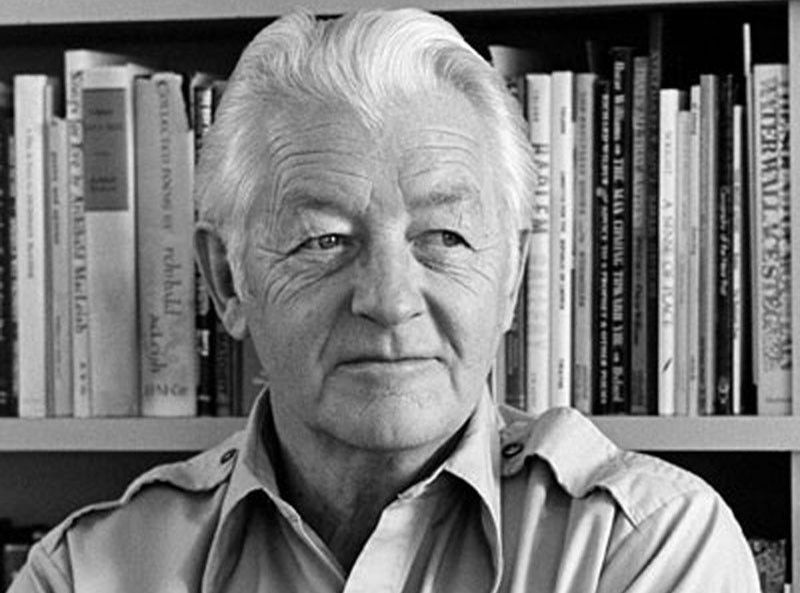Wallace Stegner in Manila

Like many of you, I’ve spent much of the lockdown opening boxes and sorting out files I haven’t touched in years. As a certified pack rat, I keep papers and other effects going back to my grade school years, so my periodic shakedowns inevitably turn up things I never knew I had, or that I’d completely forgotten about. Last month’s haul included our wedding pictures from 1974, a huge picture book of Paris from 1890, and prints from artist-friends like Orly Castillo, Joel Soliven, and the late Lito Mayo.
So amusing and engrossing were these finds that I almost missed a frayed copy of The Literary Apprentice 1951, published by the UP Writers Club and edited by two young writers, Raul R. Ingles and S. V. Epistola. I had the privilege of knowing both men when they were still alive back in the 1980s, by which time they had become venerable professors in UP. In 1951, Ingles was only 22, Epistola 26, young bucks who were already rendering literary judgment on their peers (such as Ingles’ estimation of Zoilo Galang, our first novelist in English (Child of Sorrow, 1921) of whom he writes: “The other novel (of 1950) was For Dreams Must Die by Zoilo Galang, who blundered into the literary scene. Galang was a romantic novelist of the 1920s. His mushy prose dates farther back…” That pungent style of commentary was apparently the order of the day, as elsewhere in the issue we find Homero Ch. Veloso, touted to be “UP’s most renowned poet of the past decade,” being slashed at the knees by the expatriate Jose Garcia Villa, who writes that “I think he is completely valueless; however serious he was in his esthetic and intellectual life, his writing is utterly inchoate, unformed, and ill-written…”
But what really caught my eye in this issue (where also, incidentally, Villa’s “The Bashful One” appears, among other, uhm, essentially wordless poems) was a report on the recent visit to Manila of Wallace Stegner, who had been brought over by the Rockefeller Foundation in January 1951 to deliver eight lectures, one of which touched on his impressions of Filipino writing (but only in English, of course).
Very few people, even among writers, would recognize the name these days, but Wallace Stegner (1909-1993) was a renowned American novelist who went on to win the Pulitzer Prize in 1971. His name rang a bell because of two things. First, starting in 1946, Stanford University began to offer the two-year Stegner Fellowship in creative writing, among the world’s prize fellowships for writers, whose recipients have included at least three Filipinos: the poets Valdemar Olaguer (1950) and Fidelito Cortes (1985) and the Fil-Am fictionist Lysley Tenorio (2000). Second, as luck would have it, I actually met Stegner when he visited my graduate writing class at the University of Michigan in October 1986; sadly, I don’t remember much of that visit beyond an old man in a tan overcoat, as our classes had barely begun and I was still dizzy with loneliness and awe.

Stegner’s 1951 sortie to Manila also fell in between visits by two other notable writers from America. The first was Ernest Hemingway, who came twice in 1941, in February and May, on his way to and from China with his third wife Martha Gellhorn. I received a note last month from my friend and fellow history buff in Washington, Erwin Tiongson, who found a report from The Tribune of May 13, 1941 about Hemingway being so moved by a huge fire in Tondo that he donated P500 to a fund for the victims.
Another prominent visitor was William Faulkner, who came to Manila in 1955. I recall a small poster commemorating that visit on the wall of the UPICW in the old Faculty Center before it burned down. There are records of what Faulkner did and said then — elsewhere, so I still have to find them. In the library of Stanford University is an 18-page illustrated document from 1956 published by the Philippine Writers Association titled “Faulkner on Truth and Freedom. Excerpts from tape recordings of remarks made by William Faulkner during his recent Manila visit,” but it’s only available on-site. More tantalizingly, there’s an article titled “Faulkner in Manila—1955” in Lion in the Garden: Interviews with William Faulkner, 1926-1962, edited by James Meriweather and published by Random House in 1968.
So what did Wallace Stegner have to say to his Filipino audience in 1951? He deplored the lack of novelists, for one thing. “The situation is understandable because writing a novel requires the investment of about a year’s labor, the loss of productive activity in other directions, and an attendant publishing risk,” noted the article, which went on: “The Filipino short story, Dr. Stegner observed, is more on the side of the sketch: it is a slice or cross-section rather than a well-rounded whole. Sometimes the story ends; sometimes it just stops… The Filipino writer rushes to print because he has no other alternative. He gets published easily, even on the second draft, and gets paid just the same. The result is an early sense of maturity which deceives the writer: there is nothing more to test him, to give him obstacles to get over and sharpen his writing ability. Thus, currently published stories need to be run ten times more through the typewriter to straighten out the diction and the style, to fill out the sketchiness, to clarify the characters and the moods, to smooth out all the things that make a short story.”
Funny, I thought, finding that in a 70-year-old journal, when I’d been telling my students the same thing.
* * *
Email me at jose@dalisay.ph and visit my blog at www.penmanila.ph.



















